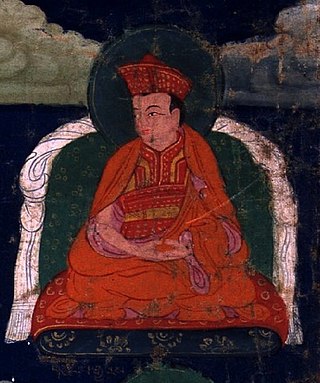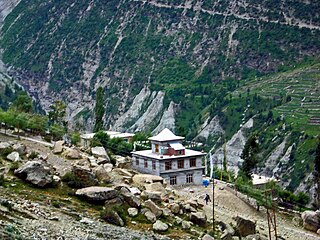The Drukpa or Drukpa Kagyu lineage, sometimes called Dugpa in older sources, is a branch of the Kagyu school of Tibetan Buddhism. The Kagyu school is one of the Sarma or "New Translation" schools of Tibetan Buddhism. The Drukpa lineage was founded in the Tsang region of Tibet by Tsangpa Gyare (1161–1211), and later became influential in Ladakh and Bhutan. It is one of several lineages known as "Red Hat sects".

Ngawang Namgyal and known colloquially as The Bearded Lama, was a Tibetan Buddhist lama and the unifier of Bhutan as a nation-state. In addition to unifying the various warring fiefdoms for the first time in the 1630s, he also sought to create a distinct Bhutanese cultural identity separate from the Tibetan culture from which it was derived.

Lamayuru or Yuru Monastery is a Tibetan Buddhist monastery in Lamayouro, Leh district, Ladakh, India. It is situated on the Srinagar-Leh highway 15 kilometres (9.3 mi) east of the Fotu La at a height of 3,510 metres (11,520 ft) and 19 km southwest of Khalsi.

Hemis, also spelled Hamis, is a village in the Leh district of Ladakh, India. It is located in the Kharu tehsil, 40 km southeast of Leh town on the Leh-Manali Highway and under-construction Bhanupli–Leh line.

The Gyalwang Drukpa is the honorific title of the head of the Drukpa Kagyu lineage, one of the independent Sarma (new) schools of Vajrayana Buddhism. This lineage of reincarnated masters started from Tsangpa Gyare, the first Gyalwang Drukpa and founder of the school. The 12th Gyalwang Drukpa, Jigme Pema Wangchen, is the current lineage holder. He was born at Lake Rewalsar, India in 1963.

Hemis Monastery is a Himalayan Buddhist monastery (gompa) of the Drukpa Lineage, in Hemis 9n the bank of Indus river, Ladakh, India. Situated 45 km from Leh, it was re-established in 1672 by the Ladakhi king Sengge Namgyal. The annual Hemis festival honouring Padmasambhava is held there in early June.

The great ascetic Drogon Tsangpa Gyare (1161–1211) was the main disciple of Lingchen Repa Pema Dorje and the founder of the Drukpa Lineage of Tibetan Buddhism the main or central branch of which was, until the 17th century, transmitted by his hereditary family lineage at Ralung in the Tsang region of Tibet. Later, following the birth of Gyalwang Je Kunga Paljor (1428–1476) considered to be the first of his re-incarnations, Tsangpa Gyare was held to be the first of a succession of Gyalwang Drukpa or Drukchen incarnations who, at the time of the fifth Gyalwang Drukpa Pagsam Wangpo (1593—1653), became established as the reincarnate leaders of the Drukpa lineage in Tibet.
The 12th Gyalwang Drukpa, Jigmet Pema Wangchen, is the head of the Drukpa Lineage school, which is one of the independent Sarma (new) schools of Tibetan Buddhism. In Drukpa, druk means 'dragon' which is a symbol of love and peace.

Gandhola Monastery is about 18 kilometres (11 mi) before Keylong in Lahaul and Spiti district, Himachal Pradesh, India on the road from Manali, Himachal Pradesh. It is located on a hill above Tupchiling Village at the sacred junction of the Chandra and Bhaga rivers, which together form the Chenab River. The village is at 3,160 m (10,370 ft) and is famous for its 7-storey tower fort.

Likir Monastery or Likir Gompa (Klud-kyil) is a Buddhist monastery in Ladakh, Northern India. It is located at 3700m elevation, approximately 52 kilometres (32 mi) west of Leh. It is picturesquely situated on a little hill in the valley, in Likir village near the Indus River about 9.5 kilometres (5.9 mi) north of the Srinigar to Leh highway. It belongs to the Gelugpa sect of Tibetan Buddhism and was established in 1065 by Lama Duwang Chosje, at the command of the fifth king of Ladakh, Lhachen Gyalpo (Lha-chen-rgyal-po). It is off the Leh-Kargil Highway, 50 km west of Leh between Alchi & Basgo, 17 km west of Basgo Monastery & 21 km northeast of Alchi Monastery.

Phyang Monastery, Phyang Gompa is a Buddhist monastery located in Fiang village, just 15 or 16 kilometres west of Leh in Ladakh, northern India. It was established in 1515.

Mulbekh Monastery or Mulbekh Gompa, at 11,495 ft from sea level and 656 ft uphill from road level, consists of 30 ft tall Maitreya Buddha statue, 1400 CE kharosti language edicts on the hill, and two 800 years old gompas, Serdung gompa of Drukpa lineage and Rgaldan-se gompa of Gelugpa lineage of Buddhism, 40 km from Kargil on NH1 Kargil-Leh Highway in Kargil district of Ladakh in northern India. Monastery has large prayer wheels and view enroute the cliff monastery are stunning. Rgaldan-se Gompa, established by Tungba Lzawa who is also known as Agu Tungba, was renovated in 2016. Nyima Lhakhang temple was built around 800 years ago in the oldest section of the Mulbekh Monastery by the students of the great Tibetan scholar Lotsawa Rinchen Zangpo, it houses Lhakhang.

Shey Monastery or Gompa and the Shey Palace complex are structures located on a hillock in Shey, 15 kilometres (9.3 mi) to the south of Leh in Ladakh, northern India on the Leh-Manali road. Shey was the summer capital of Ladakh in the past. It contains a huge Shakyamuni Buddha statue. It is the second largest Buddha statue in Ladakh.
Dzongkhul Monastery or Zongkhul Gompa is located 30 km northwest of Padum in the Stod Valley of Zanskar in Ladakh, northern India. Like the Sani Monastery, it belongs to the Drukpa school of Tibetan Buddhism
Sani Monastery, Sa-ni-[tshog], is located next to the village of Sani where the Stod Valley broadens into the central plain of Zanskar in Ladakh, northern India. It is about 6 km to the northwest of the regional centre of Padum, a gentle two-hour walk. Like Dzongkhul Monastery, it belongs to the Drukpa Kargyu school of Tibetan Buddhism, and is the only one of this order in Zanskar which has nuns. It is thought to be the oldest religious site in the whole region of Ladakh and Zanskar.

Spituk Monastery, also known as Spituk Gompa or Pethup Gompa, is a Buddhist monastery in Spituk, Leh district, Ladakh, 8 km from Leh. The site of Spituk was blessed by the Arhat Nyimagung. It was founded by Od-de, the elder brother of Lha Lama Changchub Od, when he came to Maryul in the 11th century. He introduced the monastic community. When Lotsewa (translator) Rinchen Zangpo came, he said that an exemplary religious community would arise there, and so the monastery was called spituk (exemplary). During the time of Dharma raja Gragspa Bum-Ide the monastery was restored by Lama Lhawang Lodos and the order of Tsonkhapa was introduced and it has remained intact as such till present. Founded as a Red Hat institution, the monastery was taken over by the Gelugpa in the 15th century.

Stok Monastery or Stok Gompa is a Buddhist monastery in Stok, Leh district, Ladakh, northern India, 15 kilometres south of Leh. It was founded by Lama Lhawang Lotus in the 14th Century and has a notable library including all 108 volumes of the Kangyur. A ritual dance-mask festival is held annually.

Hanle Monastery is a 17th-century gompa of the Drukpa Lineage of the Kagyu school of Tibetan Buddhism located in the Hanle Valley, Leh district, Ladakh, India on an old branch of the ancient Ladakh-Tibet trade route. The valley is home to about a thousand people, with about 300 people living in Hanle village. The monastery is home to about ten monks while another 33 or so come regularly for prayers. It is only 19 kilometres (12 mi) from the disputed frontier between India and Chinese-controlled Tibet. It is 255 km southeast of Leh, 208 km southeast of Upshi & 75 km southeast of Nyoma.
Pagsam Wangpo, a key figure in the history of the Drukpa Lineage of Tibetan Buddhism, was born at Chonggye, in the Tsang province of Tibet a natural son of the prince of Chonggye, Ngawang Sonam Dragpa. He was an elder cousin of the 5th Dalai Lama, Ngawang Lobzang Gyatso (1617-1682).
All Ladakh Gonpa Association (ALGA) is the central organisation of the Buddhist monasteries in Ladakh, India. It aims to preserve and strengthen the monastic institutions. It was founded by the 19th Kushok Bakula Rinpoche in 1949 and he acted as its president for 41 years, from 1949 until 1991. In 1949, the first meeting of the great monasteries was held and ten monasteries took part. All Ladakh Gonpa Association was registered in 1959 and is run by a governing body consisting of fifteen lama members belonging to all four major schools of Tibetan Buddhism. There are sixteen major monastic institutions with hundreds of monks in each monastery.

















